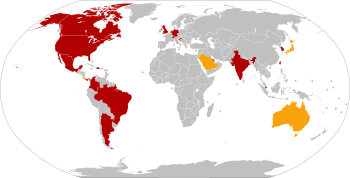Global Entry
Global Entry is a program of the U.S. Customs and Border Protection service that allows pre-approved, low-risk travelers to receive expedited clearance upon arrival into the United States through automatic kiosks at select airports and via the SENTRI and NEXUS lanes by land and sea.
[3] The Global Entry program was initially deployed in 2008 at a small number of airports, including New York-JFK (Terminal 4), Washington-Dulles and Houston-Intercontinental.
In May 2009, Global Entry membership was expanded to include Netherlands citizens who are also members of the Dutch Privium trusted traveler program under the FLUX (Fast Low-risk Universal Crossing) alliance.
[4] New York's immigrant sanctuary "Green Light Law", enacted in 2020, prohibited its state DMV from sharing criminal records with the federal Customs and Border Protection (CBP) or Immigration and Customs Enforcement (ICE) without a court order.
[6] In response to this law, on February 6, 2020, the Department of Homeland Security announced that it would immediately prohibit New York state residents from applying for or renewing trusted traveler programs including Global Entry.
[7][8][9] The Trump administration said it would reinstate access to the trusted traveler programs if New York state opened its DMV records to the federal government.
[4] Children under age 18 are exempt from the fee if their parent or legal guardian is applying at the same time or is already a member.
In any case, the program sends both an email notification and a letter stating the outcome, and this message is sent upon the interviewing officer's input of their decision.
The physical letter may contain a membership ID card (typically only included if requested via the DHS TTP web portal).
An advantage to viewing the status online is that, if approved, the Known Traveler ID ("KTN", required to be provided to participating airlines in order to receive TSA PreCheck) is supplied and may be used immediately.
Further, airports without dedicated PreCheck lanes occasionally allow cardholding members to bypass standard security: while they wait in line, a special paper is given and provided to the x-ray operator letting them know that the member does not need to remove liquids, computer or clothing.
The card is RFID enabled, so it can be used in Ready Lanes at such border checkpoints (an RFID enabled card is required for SENTRI, NEXUS and Ready lanes because data must be read wirelessly in advance to allow border guards to preprocess passengers before the vehicle arrives at the crossing station).
Applicants may not qualify if they provide false or incomplete information on the application, if they have pending criminal charges or for any other legal/customs issues (particularly, but not exclusively, for customs-related offenses) such as, for example, having previously paid a fine for transporting a prohibited or undeclared item at a port of entry in the U.S. or even abroad.
[21] A common explanation for revocation or denial of re-approval is simply that the applicant no longer meets the inclusion criteria (i.e., a full reason is not supplied).
When entering by air, enrolled members must scan their faces at kiosks[22] or through CBP's mobile app.
Enrolled members, like all other passengers, are required to carry their passports or NEXUS cards when entering by air; however, they are not always asked to present their travel documents to officers after verifying their identities via facial recognition.
[24] NEXUS is another trusted traveller program operated jointly by the U.S. Customs and Border Protection and the Canada Border Services Agency that allows pre-approved, low-risk travelers to receive expedited clearance upon arrival into the United States and Canada by air, land, and water.
Members of NEXUS can use the benefits of Global Entry if their fingerprints and passport information were collected during the interview to apply for the program.



